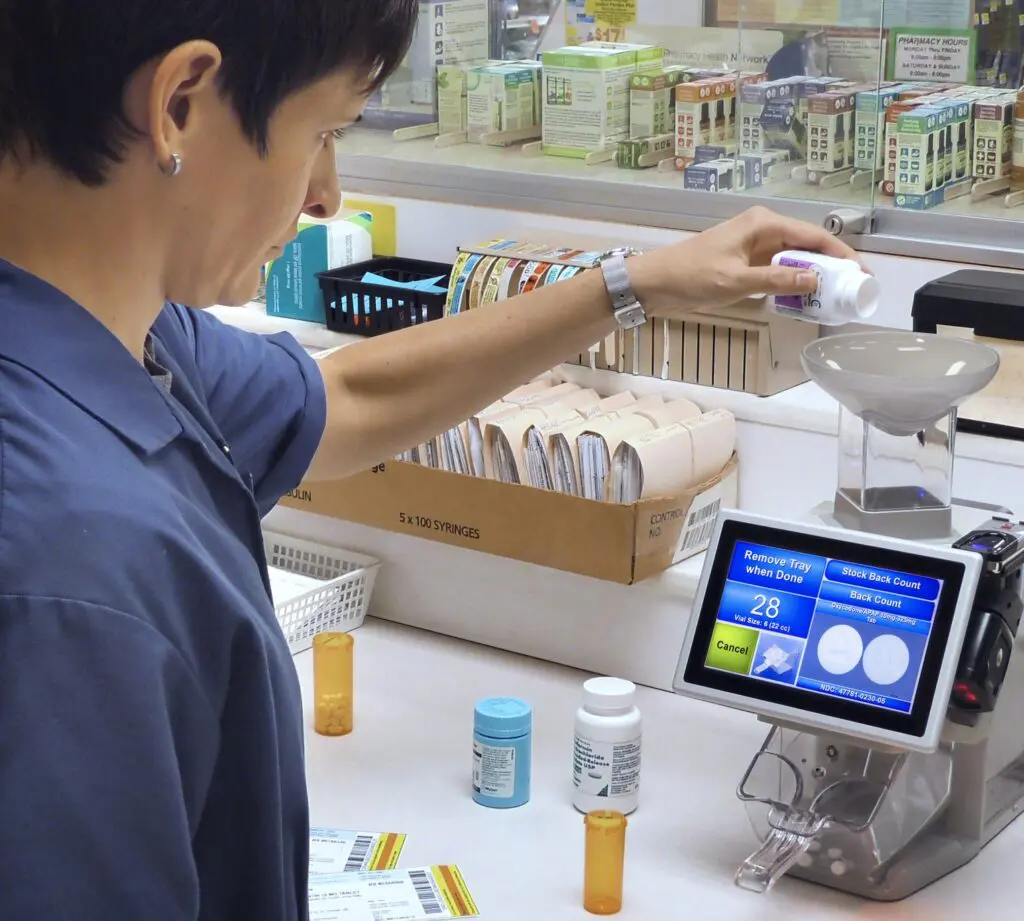
A burning topic around community pharmacies has been the DIR fees reform and its potentially profound effects on cash flow for the first two quarters of 2024. Capsa Healthcare’s pharmacy automation team is in step with proactive pharmacy owners and managers, how they are faring in the early weeks of the year, and how they’ve prepared to face the much-anticipated changes.
Direct and indirect remuneration (DIR) fees are a part of the Medicare Part D program, where pharmacy benefits managers (PBMs) charge fees to pharmacies. The Center for Medicare & Medicaid Services (CMS) first implemented these fees in 2003 to understand the exact cost of medications and manufacturer rebates.
CMS DIR fees, or price concessions, have changed substantially over the years, increasing an astonishing 107,400% from 2010 to 2020. PBMs adjusted fees based on performance measures or drug prices, creating unpredictable and inconsistent revenue.
The National Community Pharmacy Association’s 2023 Digest reported that pharmacies have struggled with DIR fees for years. “Pharmacies have been struggling with a lack of reimbursement transparency at the point of sale, often seeing direct and indirect remuneration fees and effective rate adjustments clawed back months after a prescription claim was processed in real-time.”

The new structure started in January 2024, which the NCPA says is a welcome turn of events. “Changing the third-party payment model to one that is transparent, fair, simple to understand, and compensates for value is essential to the long-term viability of independent pharmacies and the patients they serve.”
CMS issued a final rule in 2022 in response to calls for relief on these fees. After a comment period, CMS moved the DIR fee collection point and redefined some terms.
PBMs deduct DIR fees from pharmacy payments for drugs sold according to performance or other metrics. As of January 1, 2024, PBMS must include these price concessions at the point of sale as part of the final negotiated price. These changes mean that all DIR fees will no longer be retroactive. PBMs will no longer apply deductions weeks or months later. Instead, payers must reflect and collect these adjustments upfront, increasing transparency.
CMS also redefined the term negotiated prices. It currently means the amount pharmacies receive minus all the price concessions, except those that payers can’t reasonably determine at the point of sale. The new definition removes the ability to determine fees at a later date. It now defines a negotiated price as the lowest amount a pharmacy can receive as reimbursement for a covered Part D drug under its contract with the sponsor or intermediary. These new definitions eliminate unpredictability. PBMs will no longer surprise pharmacies with late assessments but will provide fair and transparent rates earlier in the claims cycle.
Geoff Dutcher, senior sales manager at Capsa Healthcare, has worked with independent pharmacies like the Pico Care Pharmacy in California over a decade. The topic of DIR reform/hangover and fee transparency has dominated conversations, such as last October’s NCPA annual conference.
Parth Parikh, owner of Pico Care Pharmacy (Pico Rivera, CA) and part of the leadership of the Indian Pharmacists Association of California (IPA), estimates the DIR Clawback topic comes up in 1 out of 5 conversations with peers. “Some people didn’t understand the severity of it as it approached,” Parikh notes. He has heard some pharmacy owners planned to avoid drawing an owner’s payout early in 2024 and return to depositing a check once cash flow normalizes. Parikh also commonly hears pharmacy owners discussing essential diversification by bringing in additional revenue sources.
What Dutcher universally says is agreed upon in conversations: the most immediate impact on pharmacies is a funding interruption, which the industry calls the DIR hangover.
The so-called DIR hangover is a shift in cash flow where DIR assessments for the end of 2023 will become due at the same time as new charges for 2024. Pharmacies will feel the pressure of deductions from two periods simultaneously, leading to fund shortfalls until the system catches up.
These cash constraints are a primary concern and will squeeze pharmacies, according to Dr. Lisa Faast. In a recent webinar by DiversifyRx, Faast says, “Cash flow has been independent pharmacies’ number one problem for a long time, and now it is on fire. When pharmacies go out of business, it’s due to cash flow gap, not profitability.”

It’s essential to keep sight of the long-term benefits for the pharmacy industry, specifically transparency. Knowledge of fees upfront will give pharmacies the tools to make better decisions. Business costs will be predictable and can help pharmacies budget for expenses and manage a revenue cycle.
Pharmacies will also see fairer reimbursements. The new rule requires PBMs to use accurate and timely rates and fees, allowing pharmacies to manage cash flow better. Pharmacies can also use this information to track reimbursements and margins and negotiate better contracts and rates.

A pharmacy should experience less financial burden. With fees upfront, pharmacies no longer have to navigate the revenue cycle with bated breath, guessing its costs and applying random pricing models to medications only to find out they didn’t charge enough to recoup expenses. Transparent and fair fees will lower the financial strain and prevent businesses from hemorrhaging losses.
Unknown fees also force pharmacies to transfer costs and inflate fees for the patient. The new rule changes that, allowing pharmacies to properly account for costs and minimize significant markup for other services. The patient will also pay lower upfront copays because they won’t need reimbursement for DIR fees later.
There are many ways to prepare, and each pharmacy may need different strategies, depending on the circumstances. However, Dutcher pulls from countless conversations with Capsa Healthcare’s independent pharmacy customers and sees trends. He suggests investigating, implementing, and exploring these common tactics, including diversification, investing in tax incentive programs, savings, and solid accounting.

Good accounting practices are essential to pharmacy management. Careful attention to transactions, costs, and billing allows owners to understand and predict cash flow problems and adjust accordingly.
Integrated software can help you capture and track DIR data and assess pharmacy performance. Use this data to decide on pricing models, inventory buying plans, and technology that can help decrease your expenses.
Additionally, cash reserves are vital, Dutcher says. “Cash flow always surfaces in conversations. Most pharmacies I spoke with were building a reserve to cover the first two quarters of 2024. Granted, that may be easier said than done.”
These reserves are emergency funds meant for this type of situation. An excellent place to start is to calculate your cash burn rate by subtracting your expenses from your total revenue in one period and dividing it by the number of months. You can add those funds to a separate account to help you avoid credit card debt or additional business loans.
Additional revenue streams have been a focus for pharmacies in recent years. Shifting away from filling prescriptions toward multiple care services creates a strong base of consistent revenue and less reliance on unpredictable PBM revenue.
Ollin Sykes, CPA, CITP, CMA, president at Sykes & Company, brings up this strategy. “It’s not just about filling scripts. It’s about diversifying revenue and creating higher margins without DIR fees. That’s the future of this business.”
Section 179 is another option. Under this tax clause, businesses deduct the entire purchase price of equipment bought during the tax year. The deduction limit for 2023 is an increase to $1,160,000.
For pharmacies, this can unlock financial relief or flexibility to invest in new technology, such as pharmacy automation. These tools help minimize dispensing costs and offer another opportunity for efficient revenue. Plus, the associated deductions will help relieve some tax burdens in April.
In early 2024, if it’s crucial to make a purchase that aligns with essential goals while also being mindful of preserving the pharmacy’s financial reserves, Dutcher recommends exploring financing options with the provider. This can range from deferred payments and split credit card payments, for instance, the short-term cushion, to a long-term benefit. “Pharmacies still need to be as efficient as possible, and if a new product could help the staff do more with less, then it may be a smart spend. Just ask that provider for options,” he says.
According to Dutcher, some pharmacies are also waiting it out. “Some pharmacies are looking at investments, but others are taking a wait-and-see approach. They feel they truly don’t know what the result of this DIR alteration will be, so it’s best to monitor.” The key here is patience and careful attention. Once you have a clear idea of how these changes will impact your business, you can make a plan with solutions that fit your needs.

DIR fees changes will likely continue to evolve. However, it signals a positive shift toward transparency that experts applaud. The challenge for community pharmacies is to weather the cash crunch and find creative ways to diversify and reduce costs.
Innovative pharmacy technology that enhances productivity with minimal financial investment, eliminates the need for extra staffing, and boosts patient safety and engagement is critical to overcome the challenges of the DIR aftermath and emerge more resilient.